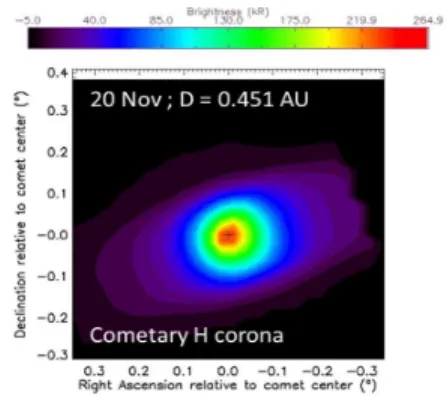HAL Id: insu-01211130
https://hal-insu.archives-ouvertes.fr/insu-01211130
Submitted on 3 Oct 2015
HAL is a multi-disciplinary open access
archive for the deposit and dissemination of
sci-entific research documents, whether they are
pub-lished or not. The documents may come from
teaching and research institutions in France or
abroad, or from public or private research centers.
L’archive ouverte pluridisciplinaire HAL, est
destinée au dépôt et à la diffusion de documents
scientifiques de niveau recherche, publiés ou non,
émanant des établissements d’enseignement et de
recherche français ou étrangers, des laboratoires
publics ou privés.
UV cometary observations by SPICAV on Venus Express
Jean-Yves Chaufray, Jean-Loup Bertaux
To cite this version:
Jean-Yves Chaufray, Jean-Loup Bertaux. UV cometary observations by SPICAV on Venus Express.
European Planetary Science Congress 2015, Sep 2015, Nantes, France. pp.EPSC2015-88.
�insu-01211130�
UV cometary observations by SPICAV on Venus Express
J-Y.Chaufray and J-L. Bertaux
LATMOS-IPSL, CNRS, Guyancourt, France
Abstract
Several campaigns of cometary observations have been performed by the UV spectrometer SPICAV from 2012 to 2014. In this presentation we will present the results obtained for the 6 observed comets and their water sublimation rates as a function of the sun distance.
1. Introduction
The production rates of water of several comets has been derived from observations of the cometary H Lyman-α emission (e.g. 1, 3). SPICAV-UV is the UV spectrometer of the Venus Express mission dedicated to the study of the venusian atmosphere (2). The orbit of Venus Express is highly elliptic with an apocenter at 66000 km above the planet center. At apocenter, the venusian emissions are very weak and observations of other objects of the solar system are possible.
2. SPICAV Observations
The observed comets are indicated in Table 1.
Comet Time period of
observations Number of runs 96P MachHolz 1 06/07/2012 – 23/07/2012 15 C/2011 L4 PanStarrs 30/01/2013 – 15/03/2013 38 C/2012 S1 ISON 22/10/2013 – 05/01/2014 99 C/2014 E2 Jacques 21/07/2014 – 15/08/2014 33 C/2012 K1 PanStarrs 24/08/2014 – 07/09/2014 26 C/2013 V5 Oukaimeden 10/10/2014 – 12/10/2014 15
Table 1 : List of the comets observed by SPICAV-UV/VEX
The cometary Lyman-αemission of atomic hydrogen has been observed for all the comets, for some comets (e.g. ISON), OH lines have also been observed near 308 nm. An example of cometary specrum of ISON measured by SPICAV-UV is displayed on Fig. 1
Fig. 1 Example of UV spectrum of the comet ISON measured by SPICAV-UV Several modes of observations were used to map the emissions of the comets, large zigzag motions of the pointing were performed to derive an extended map with a low spatial resolution and small shift of the pointing were used to obtain less extended maps but with a better spatial resolution. Example of a
Lyman-α map of ISON with a good spatial resolution is presented on Fig. 2
Fig. 2 Example of map of the Lyman-α emission around ISON obtained by SPICAV-UV
EPSC Abstracts
Vol. 10, EPSC2015-88, 2015
European Planetary Science Congress 2015
c
From these emissions, using the vectorial model of Festou (4), we have estimated the water production rates of the comets at different distances to the sun.
3. Summary and Conclusions
6 comets have been observed successfully by SPICAV-UV from 2012 to 2014. For all comets, the hydrogen Lyman-α emission is detected and for some of them (e.g. ISON), the OH emission is also detected. Spatial maps with an unp of these two emissions have been derived and will be presented as well as a first estimate of the water sublimation as a function of the sun distance.
Acknowledgements
Venus Express was a space mission from European Space Agency (ESA). We wish to express our gratitude to all ESA members who participated in this successful mission and in particular H. Svedhem, D. McCoy, O. Witasse, A. Accomazzo, and J. Louet. We thank CNRS and CNES for funding SPICAV in France.
References
[1] Bertaux, J-L. et al., A&A, 25252525, 415-430, 1973
[2] Bertaux, J-L. et al., Planet. Space Sci., 55, 1673-1700, 2007
[3] Combi, M.R. et al., Icarus, 144, 191-202, 2000 [4] Festou, M.C., A&A, 95, 69-79, 1981
